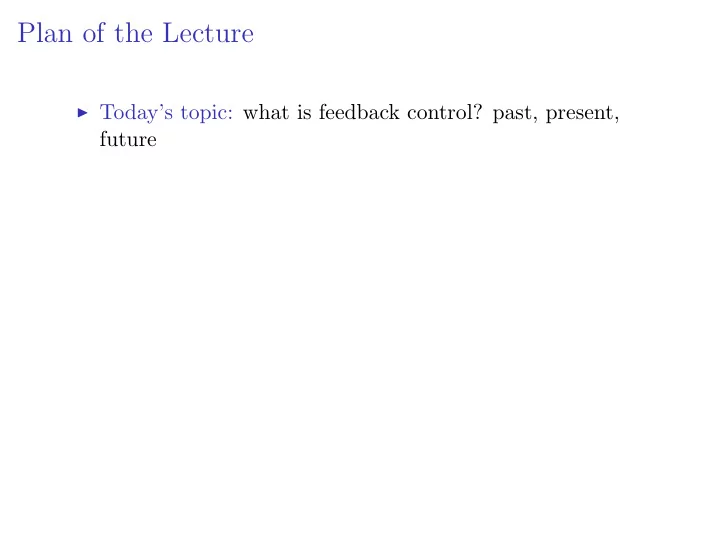

Plan of the Lecture ◮ Today’s topic: what is feedback control? past, present, future
Plan of the Lecture ◮ Today’s topic: what is feedback control? past, present, future Goal: get comfortable with the idea of feedback control as a means of getting unreliable or unstable components to behave reliably .
Plan of the Lecture ◮ Today’s topic: what is feedback control? past, present, future Goal: get comfortable with the idea of feedback control as a means of getting unreliable or unstable components to behave reliably . Recommended reading: ◮ FPE, Chap. 1 — some historical background ◮ K.J. ˚ Astr¨ om and P.R. Kumar, “Control: a perspective,” to appear in Automatica, 2014
Control All Around Us: The Thermostat Honeywell T-86 “Round” Nest 2nd Gen Learning Thermostat (1953) Thermostat (2014) The thermostat maintains desired (reference) temperature despite disturbances (such as doors opening/closing, variations of outside temperature, number of persons in the house, etc.)
Control All Around Us: The Toilet Tank The flush toilet employs a control mechanism that ensures that the toilet gets flushed and that the tank is filled to a set reference level. Similar systems are used in other applications where fluid levels need to be regulated.
Components of a Control System Some terminology: ◮ the plant is the system being controlled ◮ the sensors measure the quantity that is subject to control ◮ the actuators act on the plant ◮ the controller processes the sensor signals and drives the actuators ◮ the control law is the rule for mapping sensor signals to actuator signals
Feedback Control: Some History 1788: James Watt patents the centrifugal governor for controlling the speed of a steam engine. The governor combines sensing, actuation, and control. The original governor kept the engine running at (more or less) constant speed via what is known today as proportional control. Many improvements were added to the original design.
Feedback Control: Some History 1868: James Clerk Maxwell publishes the first theoretical study of steam engine governors. By that time, there were more than 75,000 governors installed in England.
Feedback Control: Some History 1868: James Clerk Maxwell publishes the first theoretical study of steam engine governors. By that time, there were more than 75,000 governors installed in England. J.C. Maxwell, “On governors,” Proc. Royal Society, no. 100, 1868 ... [Stability of the governor] is mathematically equivalent to the condition that all the possible roots, and all the possible parts of the impossible roots, of a certain equation shall be negative. ... I have not been able completely to determine these conditions for equations of a higher degree than the third; but I hope that the subject will obtain the attention of mathematicians.
Feedback Control: Some History 1868: James Clerk Maxwell publishes the first theoretical study of steam engine governors. By that time, there were more than 75,000 governors installed in England. J.C. Maxwell, “On governors,” Proc. Royal Society, no. 100, 1868 ... [Stability of the governor] is mathematically equivalent to the condition that all the possible roots, and all the possible parts of the impossible roots, of a certain equation shall be negative. ... I have not been able completely to determine these conditions for equations of a higher degree than the third; but I hope that the subject will obtain the attention of mathematicians. The general stability criterion was found in 1876 by Edward John Routh and, in an equivalent form, independently by Adolf Hurwitz in 1895. We will study their criterion in ECE 486.
Feedback Control: Some History Ever since the invention of the centrifugal governor, control attracted the interest of engineers, mathematicians, physicists, economists ...
Feedback Control: Some History Ever since the invention of the centrifugal governor, control attracted the interest of engineers, mathematicians, physicists, economists ... In Russia, Ivan Vyshnegradsky developed stability criteria of steam engine governors in 1876, independently of Maxwell. He was a director of St. Petersburg Technological Institute (1875–1878), and ended his career as a Minister of Finance of the Russian Empire (1887–1892).
Feedback Control: Some History Ever since the invention of the centrifugal governor, control attracted the interest of engineers, mathematicians, physicists, economists ... In Russia, Ivan Vyshnegradsky developed stability criteria of steam engine governors in 1876, independently of Maxwell. He was a director of St. Petersburg Technological Institute (1875–1878), and ended his career as a Minister of Finance of the Russian Empire (1887–1892). Some of the earliest textbooks on control: ◮ M. Tolle, Die Regelung der Kraftmaschinen , Berlin, 1905. ◮ N.E. Joukowski, The Theory of Regulating the Motion of Machines , Moscow, 1909.
Industrial Process Control Early development of controllers was driven by engineering rather than theory. The effects of integral and derivative action were rediscovered by tinkering.
Industrial Process Control Early development of controllers was driven by engineering rather than theory. The effects of integral and derivative action were rediscovered by tinkering. Some interesting facts: ◮ By mid-1930’s, there were more than 600 control companies in the U.S. ◮ In 1931, Foxboro developed the Stabilog — the first general-purpose proportional-integral-derivative (PID) controller, with adjustable gains from 0 . 7 to 100 ◮ Between 1925 and 1935, about 75,000 controllers were sold in the U.S. – K.J. ˚ Astr¨ om and P.R. Kumar, “Control: a perspective,” to appear in Automatica, 2014
Insights from Flight Control 1905: Orville and Wilbur Wright made the first successful experiment with manned flight.
Insights from Flight Control 1905: Orville and Wilbur Wright made the first successful experiment with manned flight. Their main insight was that the airplane itself had to be inherently unstable, which would give the pilot more control and render the overall flying system (pilot and machine) stable. The first autopilot was developed by Sperry Corp. in 1912.
Recommend
More recommend